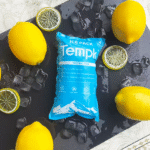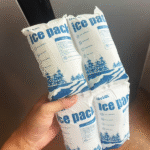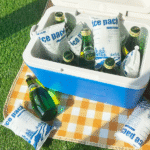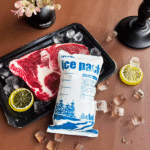يعتمد وجود التلوث في عبوات الثلج بشكل أساسي على موادها واستخدامها. في بعض الحالات, if the material or manufacturing process of the ice pack does not meet food safety standards, there may indeed be contamination issues. Here are some key considerations:
1. التكوين الكيميائي:
-Some low-quality ice packs may contain harmful chemicals such as benzene and phthalates (a commonly used plasticizer), which can pose a health hazard. These chemicals may seep into food during use, especially in high temperature environments.
2. Damage and leakage:
-If the ice bag is damaged or leaked during use, the gel or liquid inside may come into contact with food or drinks. Although most ice bag fillers are non-toxic (such as polymer gel or saline solution), direct contact is still not recommended.

3. Product certification:
-When choosing an ice pack, check for food safety certification, such as FDA approval. These certifications indicate that the material of the ice pack is safe and suitable for contact with food.
4. Correct use and storage:
-Ensure the cleanliness of ice packs before and after use, and store them properly. Avoid coexisting with sharp objects to prevent damage.
-عند استخدام حزمة ثلج, it is best to place it in a waterproof bag or wrap it with a towel to avoid direct contact with food.
5. Environmental issues:
-Considering environmental protection, reusable ice packs can be chosen, and attention should be paid to the recycling and disposal methods of ice packs to reduce environmental pollution.
باختصار, choosing high-quality and appropriately certified ice packs, and using and storing them correctly, can minimize the risk of pollution. If there are special safety concerns, you can have a detailed understanding of product materials and user reviews before purchasing.
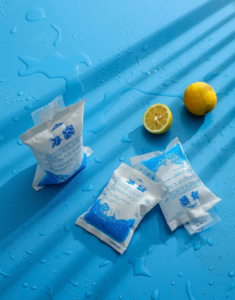
The main components of refrigerated ice packs
Refrigerated ice packs are typically composed of several key materials aimed at providing good insulation and sufficient durability. The main materials include:
1. مادة الطبقة الخارجية:
-نايلون: خفيفة الوزن ودائم, commonly used on the outer layer of high-quality ice packs. Nylon has good wear resistance and tear resistance.
-البوليستر: Another commonly used outer layer material, slightly cheaper than nylon, and also has good durability and tear resistance.
-Vinyl: Suitable for applications that require waterproofing or easy to clean surfaces.
2. مادة العزل:
-رغوة البولي يوريثان: it is a very common insulating material, and is widely used in refrigerated ice bags due to its excellent thermal insulation performance and lightweight characteristics.
-البوليسترين (EPS) رغوة: also known as styrofoam, this material is commonly used in portable cold boxes and some one-time cold storage solutions.
3. Inner lining material:
-رقائق الألومنيوم أو فيلم معدني: commonly used as lining material to help reflect heat and maintain internal temperature.
-غذاء الصف PEVA (polyethylene vinyl acetate): A non-toxic plastic material commonly used for the inner layer of ice bags in direct contact with food, and is more popular because it does not contain PVC.

4. عصا:
-كيس جل: bag containing special gel, which can keep cooling effect for a long time after freezing. Gel is usually made by mixing water and polymer (مثل polyacrylamide), sometimes preservative and antifreeze are added to improve performance.
-Salt water or other solutions: Some simpler ice packs may only contain salt water, which has a freezing point lower than pure water and can provide longer cooling time during refrigeration.
When choosing a suitable refrigerated ice bag, you should consider whether its material meets your specific needs, especially whether it requires food safety certification, and whether the ice bag needs frequent cleaning or use in specific environments.
The main components of frozen ice packs
تتكون علبة الثلج المجمدة عادة من المكونات الرئيسية التالية, كل منها مع وظائف محددة لضمان أن حزمة الثلج المجمدة تحافظ بشكل فعال على درجات حرارة منخفضة:
1. مادة الطبقة الخارجية:
-نايلون: النايلون متين, ضد للماء, ومواد خفيفة الوزن مناسبة لأكياس الثلج المجمدة التي تتطلب حركة متكررة أو استخدام في الهواء الطلق.
-البوليستر: البوليستر هو مادة متينة شائعة شائعة الاستخدام بشكل شائع للقشرة الخارجية للأكياس الجليدية المجمدة, مع قوة جيدة ومقاومة ارتداء.
2. طبقة العزل:
-رغوة البولي يوريثان: إنها مادة عزل فعالة للغاية, ويستخدم على نطاق واسع في أكياس الجليد المجمدة بسبب قدرتها على الاحتفاظ بالحرارة الممتازة.
-البوليسترين (EPS) رغوة: المعروف أيضًا باسم رغوة الستايرين, هذه المواد خفيفة الوزن تستخدم أيضًا في التبريد والمنتجات المجمدة, خاصة في حلول التبريد لمرة واحدة.
3. بطانة داخلية:
-رقائق الألومنيوم أو فيلم معدني: تُستخدم هذه المواد بشكل شائع كبطانات للمساعدة في عكس الطاقة الحرارية وتعزيز تأثيرات العزل.
-غذاء الصف PEVA: هذه مادة بلاستيكية غير سامة شائعة الاستخدام للطبقة الداخلية لحزم الثلج, ضمان اتصال آمن مع الطعام.
4. عصا:
-هلام: الحشو شائع الاستخدام لأكياس الجليد المجمدة هو هلام, الذي يحتوي عادة على الماء, البوليمرات (مثل polyacrylamide) وكمية صغيرة من الإضافات (مثل المواد الحافظة والتجمد). يمكن أن تمتص هذه الهلام الكثير من الحرارة وتطلق ببطء تأثير التبريد بعد التجميد.
-محلول الماء المالح: في بعض عبوات الثلج البسيطة, يمكن استخدام الماء المالح كمبرد لأن نقطة التجمد في الماء المالح أقل من تلك الموجودة في الماء النقي, توفير تأثير تبريد طويل الأمد.
عند اختيار حزم الثلج المجمد, من المهم التأكد من أن مواد المنتج المحددة آمنة, صديقة للبيئة, ويمكن أن تلبي احتياجاتك المحددة, مثل الحفاظ على الأغذية أو الأغراض الطبية. في أثناء, فكر في حجم وشكل حزم الثلج للتأكد من أنها مناسبة للحاوية أو مساحة التخزين الخاصة بك.


















